

 | Energy Engineering |  |
DOI: 10.32604/ee.2022.014942
ARTICLE
Assessment Framework of Green Intelligent Transformation of Small Hydropower in China
Zhejiang Electric Power Industry Corporation, Hangzhou, 310006, China
*Corresponding Author: Jun Shi. Email: kingmax47@tom.com
Received: 09 November 2020; Accepted: 21 December 2020
Abstract: With the comprehensive promoted construction of the establishment of green small hydropower, the defects of existing small hydropower station are gradually emerging, and it is necessary to implement green intelligent transformation to promote the construction of energy internet in China. This study focuses on constructing a green intelligent planning and transforming assessment framework, and assists management department to filtrate the small hydropower stations which can be transformed reasonably. Firstly, power station economy, ecological environment, technical safety management and social benefits are involved in the assessment index system. Secondly, multi-expert judgment aggregation based on fuzzed comparison scale is put forward to calculate the index value, and evidence synthesis is used to comprehensively assess the feasibility of green and intelligent planning and transformation for several small hydropower stations. The simulation case analysis shows the constructed assessment framework can reflect the actual situation of objectives properly and would provide decision-making basis for green and intelligent planning and transformation of small hydropower stations.
Keywords: Small hydropower; green intelligent transformation; multi-expert judgment; evidence synthesis
In order to deal with the ecological and environmental problems caused by the development of small hydropower, China proposes to create a green small hydropower policy, and emphasizes that the grid power of small hydropower with green certification will be fully purchased by power grid enterprises [1]. With the comprehensive promoted construction of the, ‘Three Types and Two Networks’, and the green small hydropower established, the defects of existing small hydropower are gradually emerging, and it is necessary to carry out green intelligent reconstruction to promote the construction of energy internet in China. Green small hydropower construction focuses on the improvement of river ecology, and cannot fully enhance the functionality of small hydropower, reduce staff, increase efficiency and reduce operating costs. Therefore, the State Energy Bureau put forward the idea of optimizing the transformation of small hydropower in the “13th five-year plan” of hydropower development, and carried out pilot construction of “Internet +” intelligent hydropower station, so as to realize the friendly interaction between smart grid and intelligent energy network [2]. Combined with the national ecological priority principle and the enterprise, s vision of improving the operation efficiency of power station, the concept of green and intelligent transformation of small hydropower station came into being. The green and intelligent transformation of small hydropower station is based on the establishment of green small hydropower station, with the improvement of economic benefits of power station as the core value of construction, focusing on the realization of small hydropower to help rural revitalization and sustainable development of river ecology. This is not only conducive to the country to promote the construction of green small hydropower, but also conducive to enterprises to improve the level of power station productivity, so green intelligent small hydropower will become the main development direction of China’s small hydropower in the future.
At present, the cost of some intelligent equipment is high, and the small hydropower needs the support of national funds to smoothly carry out green intelligent transformation. However, there are tens of thousands of small hydropower stations, the investment return rate of transformation is large, the hydropower is low, and the national support fund is limited, and not all small hydropower stations are suitable for transformation [1–3]. Therefore, it is necessary to plan the transformation of small hydropower stations and clarify the objectives, objects and time sequence of the transformation. In terms of planning and reconstruction objects, large hydropower stations can be determined as intelligent construction objects according to their functions because of their large scale, high degree of comprehensive automation, good overall benefits and national investment and development management. However, the comprehensive automation degree of small hydropower stations is low, the installed capacity is small, and most of them are operated by private capital, so it is impossible to determine whether they can be used as green and intelligent transformation objects through a single dimension. Therefore, it is necessary to build a multi-dimensional evaluation system as the basis for planning and decision-making from the perspective of the state and enterprises, so as to realize the public selection of small hydropower stations and ensure that the power stations can play a leading demonstration effect after transformation.
Many institutions and scholars have begun to study the hydropower assessment framework and relevant certification standards. Bratrich et al. [3] found that environmental impact assessment of hydropower projects must be performed considering all aspects and factors which affect the environmental impacts associated with hydropower projects. Nautiyal et al. [4] used the concept of the causal diagram to structure and represent hydropower impacts in a generic form through causal networks. Voegeli et al. [5] suggested an expert fuzzy-TOPSIS multiple criteria decision-making (MCDM) methodology for the initial cost estimation of a hydropower project, which contributed to the limited research available concerning the analysis of risk factors for the cost assessment of a hydropower project. Through field investigation, laboratory analysis, model calculation, and statistical analysis, Agarwal et al. [6] studied the debris flows occurring in the gullies near the Baihetan hydropower station to determine the characteristics of their dynamic parameters and the effectiveness of existing debris flow control measures, and the results could be applied for the development of evaluation methods of the effectiveness of other similar and significant projects in China and elsewhere. Switzerland carries out green hydropower certification from five aspects: minimum flow, peak regulation, reservoir management, sediment management and power station design [7]. The United States has formulated low impact Hydropower Certification standards from multiple dimensions. According to the four different stages of hydropower station construction, preparation, implementation and operation, the International Hydropower Association has established the corresponding hydropower sustainability assessment specifications [8,9]. Chen et al. [10] introduced the impact of biodiversity into the environmental impact assessment of water conservancy and hydropower projects to provide decision support for water conservancy and hydropower development and construction; Zhao et al. [11] established a 5-level River Basin Hydropower sustainability evaluation index system based on the basin hydropower development system characteristics; The Ministry of water resources issued the “green small hydropower evaluation standard” in 2017, which is used as the evaluation basis for whether small hydropower can become green small hydropower [12,13]. The above research results mainly focus on the assessment of the impact of the power station on the ecological environment, and build a wealth of green ecological indicators, but lack of relevant indicators to evaluate the feasibility of intelligent transformation.
In order to fill this gap, this paper constructs an assessment framework which can simultaneously assess the green development status of small hydropower station and the feasibility of intelligent transformation. In the constructed framework, an index system is built which is suitable for different types of small hydropower stations and can provide decision-making basis for planning departments. A integrated method based on multi-expert judgment aggregation and evidence synthesis is proposed to assess the small hydropower stations.
The rest of this work is arranged as follows: Influencing factors of small hydropower green intelligent transformation is stated in Sections 2, 3 builds the assessment index system for green intelligent transformation of small hydropower assessment, while Section 4 illustrates the detailed assessment method; case study is given in Section 5 by an application of six small hydropower stations in Guangxi; Section 6 presents a discussion of the results; finally, Section 7 summarizes the conclusion.
2 Influencing Factors of Small Hydropower Green Intelligent Transformation
At present, there are 46515 small hydropower stations in China, with a total installed capacity of 80.435 million kilowatts, accounting for 62.8% of the country, s rural hydropower resources technology development, and the annual power generation is 234.56 billion kwh, accounting for 43.8% of the exploitable capacity [13]. The characteristics of power stations are as follows: (1) most of the small hydropower stations are runoff type, and their economic benefits are closely related to the water inflow of the basin; (2) there are tens of thousands of small hydropower stations, and the construction density of power stations in the basin is high; (3) the functional requirements of power stations in the initial stage of construction are not high, and the level of automation and intelligence is low; (4) the technical transformation of power stations often relies on the support policies of the state for small hydropower stations.
In the process of evaluating whether the small hydropower station is suitable for green intelligent transformation, the characteristics of small hydropower station and the construction requirements of green intelligent hydropower station should be referred. After the summary of the existing research [3–13], the assessment of green intelligent transformation of small hydropower can be measured from the following four aspects.
• Whether the small hydropower has the potential to improve the quality and efficiency and has enough funds to support the reconstruction and construction;
• Whether the power station meets the requirements of green sustainable development;
• The difficulty to be overcome in the intelligent transformation;
• Whether the intelligent transformation can obtain the support of the society and the government.
Along these four aspects, four basic influencing factors can be determined as power station economy, ecological environment, technical safety management and social benefits. In this paper, starting from the four basic factors, combined with the structural characteristics and hydropower development strategy of small hydropower, further select a series of factors to specifically characterize the four basic influencing factors, so as to objectively reflect the current situation of small hydropower, and help to carry out the evaluation of green and intelligent planning and transformation of small hydropower.
3 Assessment Index System for Small Hydropower Green Intelligent Transformation
In order to make the evaluation index system comprehensively reflect the actual situation of the power station and the feasibility of green intelligent transformation, this paper takes the relevant influencing factors of green and intelligent transformation of small hydropower stations as the starting point, and refers to a large number of relevant standards and norms such as the 13th five year plan for hydropower development, the evaluation standards for green small hydropower stations and the technical guidelines for intelligent hydropower plants [14], to realize the sea selection of indicators Delphi method [15] is used to screen the sea selection indexes, and the assessment index system for small hydropower green intelligent transformation is constructed as shown in Fig. 1. There are four attributes A1–A4 and nineteen indexes I1–I19. The mathematical descriptions of the attributes and indexes are as follows: (1) attributes:

Figure 1: Assessment index system
Among them, in the dimension of power station economic and technical safety management, the indicators are selected based on the purpose of reflecting the actual operation status of small hydropower enterprises, and the index data type is mainly real number type, so as to ensure the objectivity in the evaluation process of small hydropower operation status. In the dimension of ecological environment and social benefits, indicators are selected to show the impact of small hydropower on the surrounding environment and adjacent mountain villages. Because there are few real number indicators corresponding to these two dimensions, the fuzzy indicators reflecting the improvement of river ecology and rural revitalization by small hydropower are selected in this paper.
4 Assessment Method of Small Hydropower Green Intelligent Transformation
Because most of the index data types in the assessment index constructed in this paper are fuzzy, and the dimensionless processing of real number indexes is affected by sample data, which is not conducive to the assessment of a large number of small hydropower stations. Therefore, this paper introduces trapezoidal fuzzy number into multi-expert judgment method [16,17] for the index value assignment. Considering the limited cognitive level of experts, it may be impossible to judge the index value of some assessment objects, so the index value of some evaluation objects is allowed to be null or interval value.
4.1.1 Fuzzed Comparison Scale Method
According to the membership function of trapezoidal fuzzy number [18–20], natural numbers 1 to 9 are converted into corresponding trapezoidal fuzzy numbers as shown in Table 1.

Traditional nine-level comparison scale method is revised based on the conversion of natural number and trapezoidal fuzzy number shown in Table 1. Based on the arithmetic operation principles of trapezoidal fuzzy number, the nine-level comparison scale method is fuzzed and its revised method is shown in Table 2.
4.1.2 Multi-Expert Judgment Aggregation
Multiple experts investigate the basic data of the small hydropower stations to be assessed firstly. After that, they give their judgment of the performance of the hydropower stations on each index, which is represented by fuzzed nine-level comparison scale method shown in Table 2. It is assumed that there are m small hydropower stations to be assessed and p experts. The judgment of expert s for hydropower station i on index
According to the arithmetic operation principles of trapezoidal fuzzy number,

Then the index value matrix can be obtained as
Based on D-S theory [21–23], the discernment frame is constructed by treating m small hydropower stations to be assessed as elements. Then the discernment frame of small hydropower assessment in this paper is defined as follows:
Here
Basic probability assignment (BPA), which is the most basic information carrier in D-S theory, is a function named as BPA function
For
Here
Normalization constant K is defined as follows:
It is assumed that the weight vectors of attributes and indexes are as follows:
According to the index system in Fig. 1, weight vectors
Because the index system in Fig. 1 shows a two-story structure, the assessment of small hydropower in discernment frame
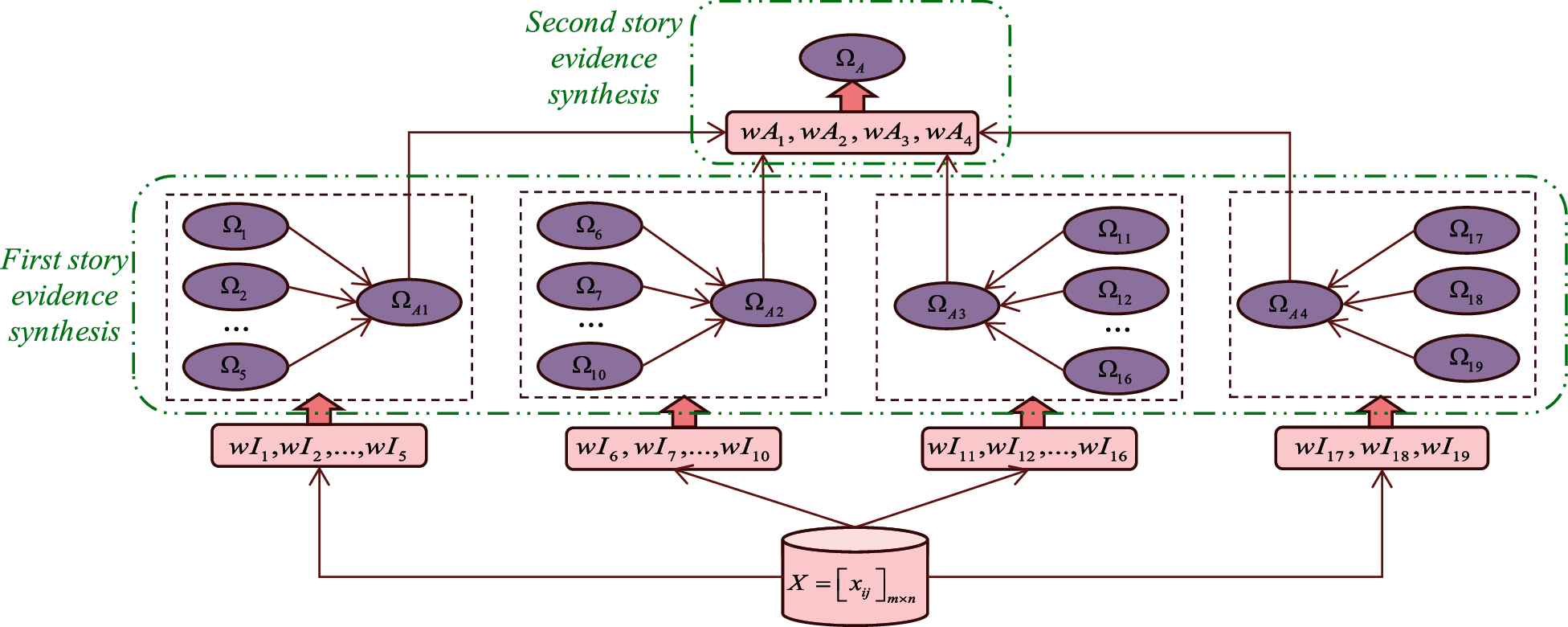
Figure 2: Evidence synthesis process
In this paper, focal elements include m small hydropower stations to be assessed and the special focal element
The specific process of evidence synthesis is given below. Taking the indexes that belong to attribute A1 as an example, the evidences are the BPA functions of m small hydropower stations to be assessed. According to the evidence synthesis principle Eq. (4), BPA function
Here normalization constant K is as follows:
Similarly, BPA functions
Next BPA function
Normalized BPA function
Then by treating normalized BPA functions
Here normalization constant K is as follows:
According to D-S theory, BPA function
As a result, the small hydropower stations are assessed and the ranking result of them can be obtained by sorting BPA functions
This paper takes 6 small hydropower stations in Guangxi as an example to carry out the assessment of green intelligent planning and transformation. Relevant data of each hydropower station are obtained through field investigation, as shown in Table 3.

There is a correlation between the basic data of small hydropower station and the assessment index system. The correlation is very complex. This paper does not study the relationship between the two, but uses expert evaluation method to solve this problem. Combined with the relevant data of each power station, the experts use fuzzed comparison scale method to assign the index of each assessment object. There are 60 experts. Their judgment scales about hydropower station 1 are shown in Table 4. The data in Table 4 is the number of experts giving the corresponding judgment scale. Using multi-expert judgment aggregation Eq. (1), the fuzzy index value of hydropower station 1 are obtained.

Then by Eq. (2), the fuzzy index value of hydropower station 1 is converted into real number value, which is shown in the 1st column of Table 5. Other columns of Table 5 are the index value data of else hydropower stations, which are obtained by same method.
Assuming that the weight assignment is given by decision-makers as shown in Table 6, below is the evidence synthesis process.
According to the index value shown in Table 5 and index weight shown in Table 6, the two-story evidence synthesis shown in Fig. 2 is implemented for the assessment of small hydropower stations as follows.
Based on Eq. (12), the weighted BPA functions of all focal elements on each index are obtained as shown in Table 7. Here, to make the data more efficient in finite digits, the index weight values are expanded proportionally. For example the maximum weight value (wI16 = 0.0803) is expanded to 0.95.




According to Eqs. (13) and (14), evidence synthesis is carried out based on the data in Table 7. BPA functions
Through Eq. (15), BPA functions

According to Eqs. (16) and (17), evidence synthesis is carried out based on the data in Table 9. Total BPA function

The ranking result of 6 small hydropower stations in Guangxi can be obtained by sorting total BPA functions in descending order. Therefore, the assessment result of green intelligent planning and transformation in this case is: hydropower station 3, hydropower station 4, hydropower station 6, hydropower station 2, hydropower station 1 and hydropower station 5. Hydropower station 3 is the optimal hydropower station.
According to the index value data in Table 5 and weight assignment data in Table 6, VlseKriterijumska Optimizacija I Kompromisno Resenje (VIKOR) [24] and Preference Ranking Organization Method for Enrichment of Evaluations II (PROMETHEE II) [25] are adopted to make the comparison experiments for the feasibility verification of the proposed assessment framework. The comparison of the ranks of the 6 small hydropower stations based on the proposed framework, VIKOR and PROMETHEE II is shown in Table 11. As can be seen in Table 11, ranking of the 6 small hydropower stations according to the different approaches used in order to evaluate of the reliability of the results shows that hydropower station 3 remained in first place for all approaches (proposed framework, VIKOR and PROMETHEE II), while hydropower station 3 and hydropower station 4 are the top two hydropower stations and hydropower stations 1 and 5 are the last two hydropower stations. There is a change in the ranking of hydropower stations 2 and 6 using VIKOR whereby they changed places; while there also is a change in the ranking of hydropower stations 1 and 5 using PROMETHEE II whereby they changed places. Therefore, it shows that the framework proposed in this paper is feasible. In view of the advantages of evidence synthesis theory in dealing with the conflict between index values, the results obtained by this proposed framework are more reliable than VIKOR and PROMETHEE II.

Based on the data in Table 7, comparative analysis of the weighted BPA functions of 6 hydropower stations on the 19 indexes are shown in Figs. 3–6.
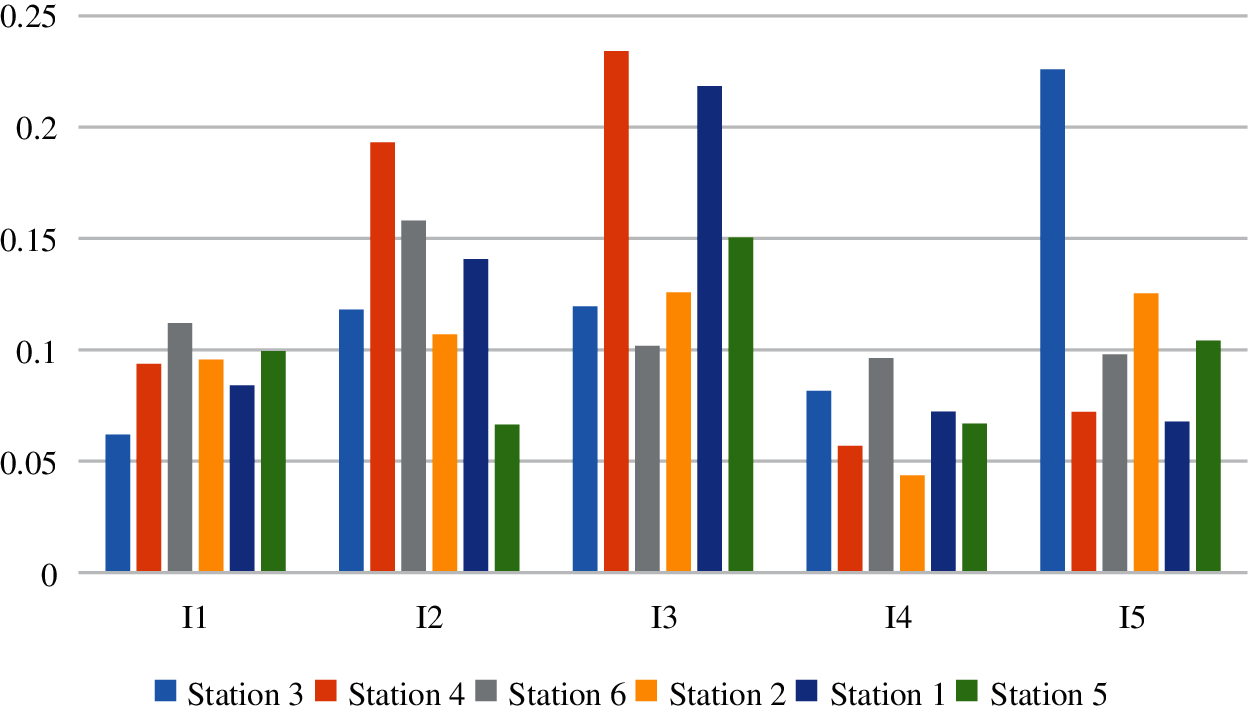
Figure 3: Comparative analysis of the weighted BPA functions of 6 hydropower stations: on the five indexes of power station economy attribute
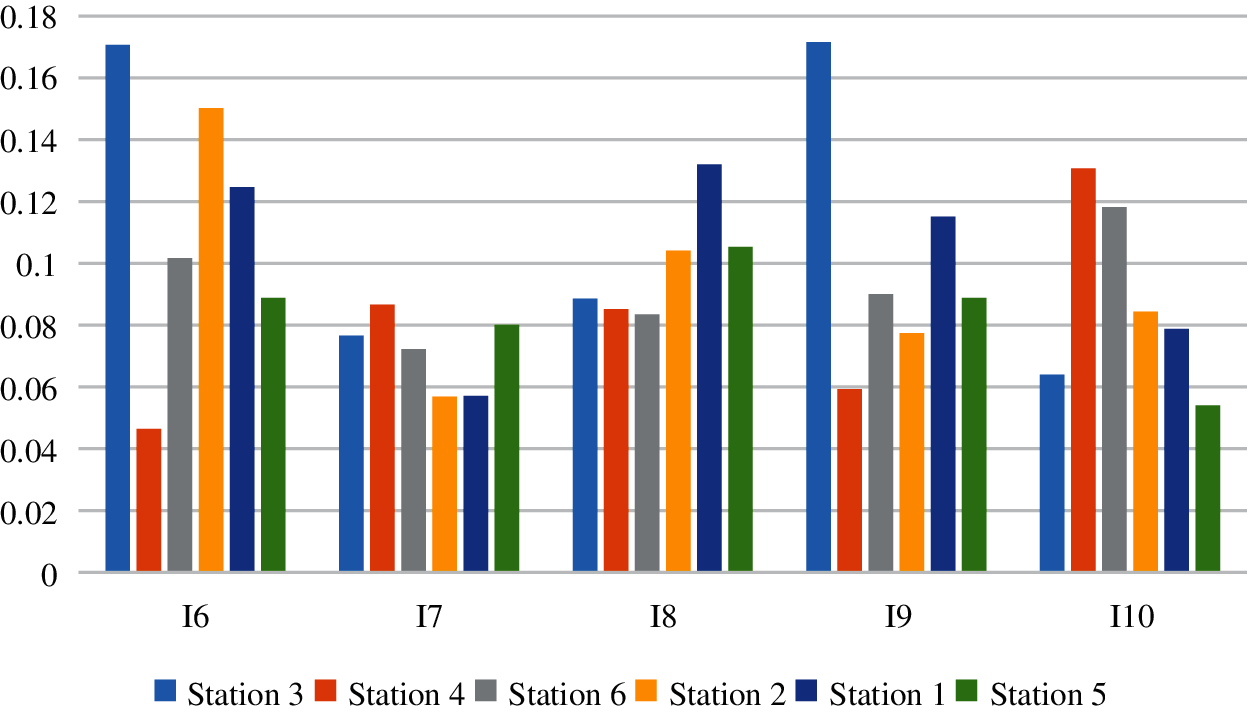
Figure 4: Comparative analysis of the weighted BPA functions of 6 hydropower stations: on the five indexes of ecological environment attribute
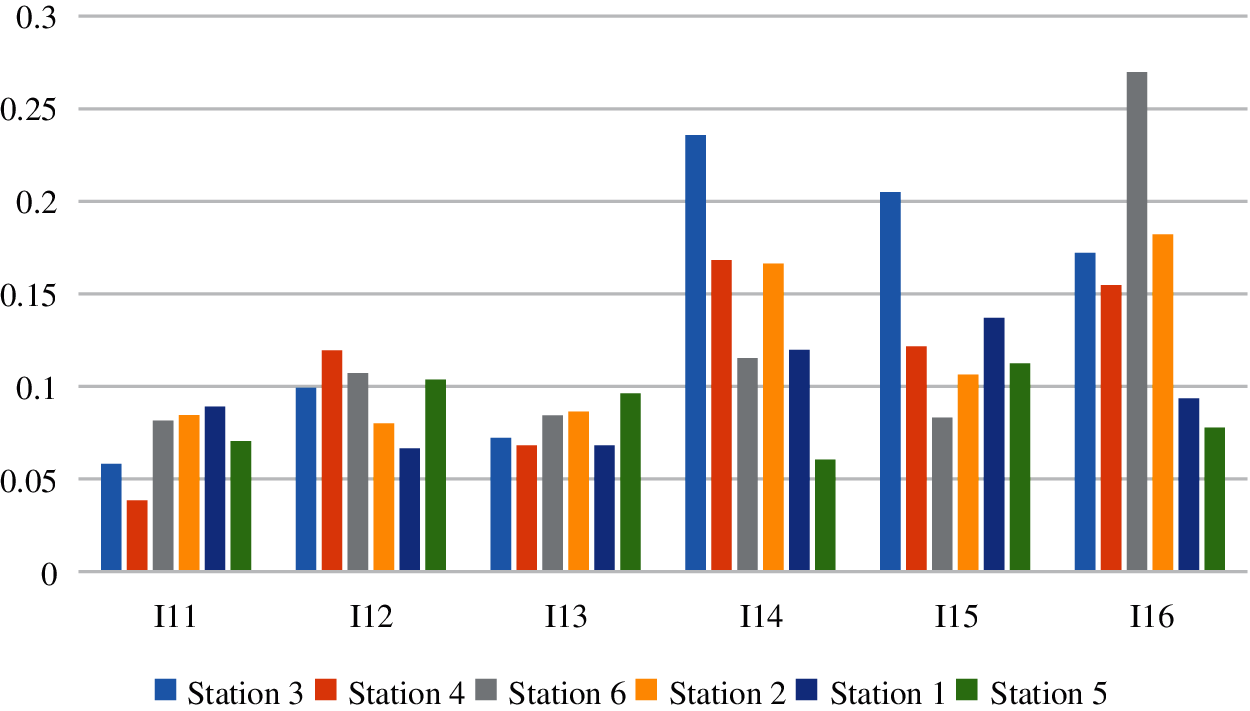
Figure 5: Comparative analysis of the weighted BPA functions of 6 hydropower stations: on the six indexes of technical safety management attribute
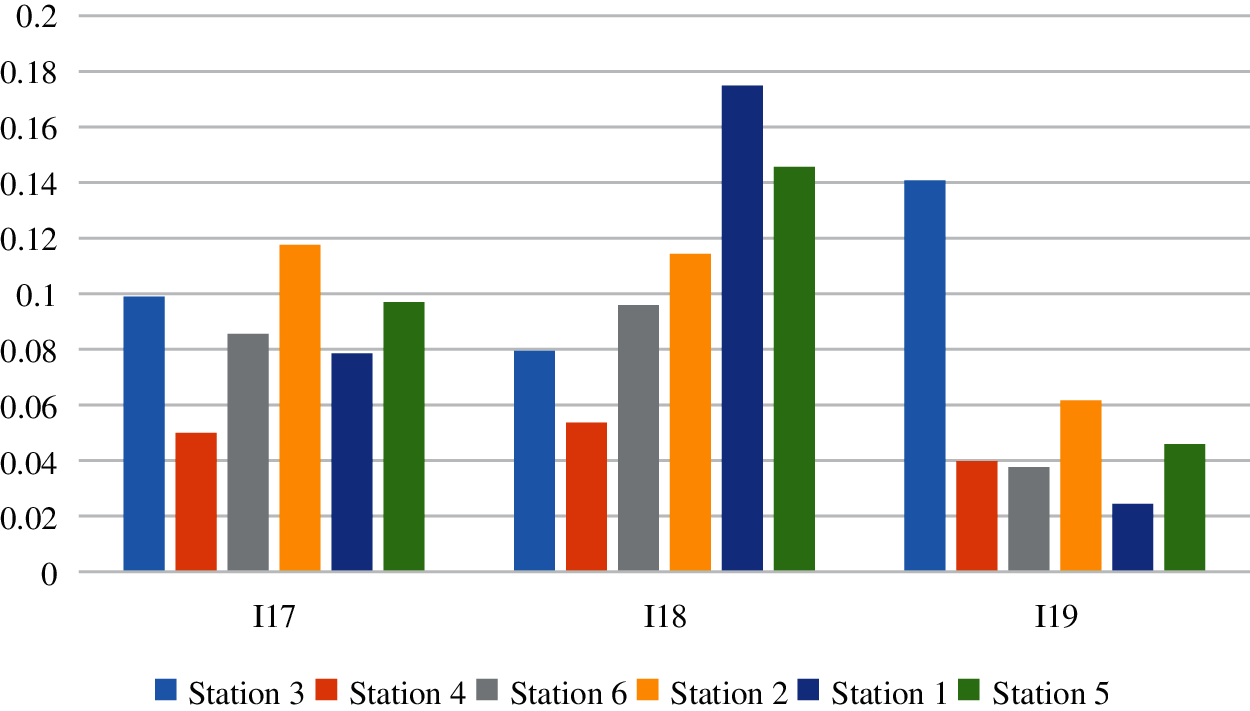
Figure 6: Comparative analysis of the weighted BPA functions of 6 hydropower stations: on the three indexes of social benefits attribute
Based on the data in Table 9, comparative analysis of the normalized BPA functions of 6 hydropower stations on the four attributes are shown in Fig. 7.
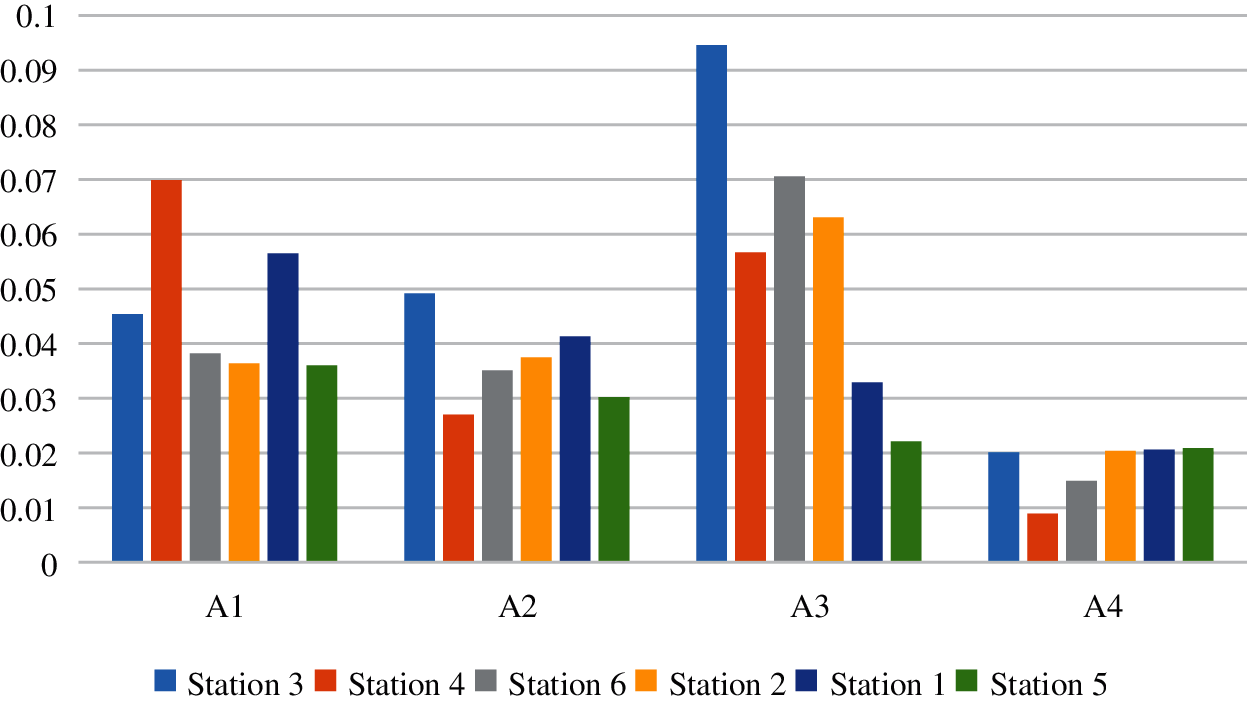
Figure 7: Comparative analysis of the normalized BPA functions of 6 hydropower stations on the four attributes
It can be seen from Table 10, Figs. 3–7 that the index system (Fig. 1) constructed in this paper takes into account the green and intelligent assessment of power stations and the proposed assessment method can reasonably classify the power stations. Fig. 3 shows the development potential and fund-raising capacity of 6 small hydropower stations; Fig. 4 shows the current situation of green and sustainable development of 6 small hydropower stations; Fig. 5 reflects the difficulty of intelligent transformation of various hydropower stations; and Fig. 6 shows the social influence of various hydropower stations. Compared with other hydropower stations, 3 and 4 have obvious advantages in four attributes, which not only meet the requirements of green development, but also have the feasibility of intelligent transformation, so they can be directly planned and transformed.
In this paper, the assessment framework of green and intelligent planning and transformation of small hydropower stations is studied. 19 indexes are selected from four dimensions to form the assessment index system of green and intelligent planning and transformation of small hydropower stations. Multi-expert judgment aggregation based on fuzzed comparison scale and two-story evidence synthesis are used to comprehensively assess the green and intelligent planning and transformation of 6 small hydropower stations. The following conclusions can be drawn through the application analysis of the example.
(1) The assessment index system and comprehensive assessment method constructed in this paper can carry out scientific and objective assessment of small hydropower stations, and achieve classification transformation according to the evidence synthesis result, which provides decision-making basis for green and intelligent planning and transformation of small hydropower stations.
(2) For the green intelligent small hydropower station which is in the initial development stage, trapezoidal fuzzy number is more suitable for experts to carry out index assignment work.
(3) Evidence synthesis can reduce personal subjective interference, extract more abundant and accurate information from index value set, and further obtain objective and accurate decision-making results.
Funding Statement: The author received no specific funding for this study.
Conflicts of Interest: The author declares that he has no conflicts of interest to report regarding the present study.
1. Liu, J., Yang, X., Chen, N., Duan, J. (2020). Loss allocation of distribution network with small hydropower groups. Smart Power, 48(7), 93–99. DOI 10.1088/1755-1315/474/6/062019. [Google Scholar] [CrossRef]
2. Liu, S., Chen, J., Guan, S. (2020). Ecological flow calculation and ecological operation of small hydropower based on modified flow duration curve method. Journal of Yangtze River Scientific Research Institute, 37(8), 29–34. DOI 10.11988/ckyyb.20190462. [Google Scholar] [CrossRef]
3. Bratrich, C., Truffer, B., Jorde, K. (2004). Green hydropower: A new assessment procedure for river management. River Research and Applications, 20(7), 865–882. DOI 10.1002/(ISSN)1535-1467. [Google Scholar] [CrossRef]
4. Nautiyal, H., Goel, V. (2020). Sustainability assessment of hydropower projects. Journal of Cleaner Production, 265(1), 121661. DOI 10.1016/j.jclepro.2020.121661. [Google Scholar] [CrossRef]
5. Voegeli, G., Hediger, W., Romerio, F. (2019). Sustainability assessment of hydropower: Using causal diagram to seize the importance of impact pathways. Environmental Impact Assessment Review, 77(6), 69–84. DOI 10.1016/j.eiar.2019.03.005. [Google Scholar] [CrossRef]
6. Agarwal, S., Kansal, M. (2020). Risk based initial cost assessment while planning a hydropower project. Energy Strategy Reviews, 31(1), 100517. DOI 10.1016/j.esr.2020.100517. [Google Scholar] [CrossRef]
7. Hu, G., Tian, S., Chen, N., Liu, M., Somos-Valenzuela, M. (2020). An effectiveness evaluation method for debris flow control engineering for cascading hydropower stations along the Jinsha River. China Engineering Geology, 266(2), 105472. DOI 10.1016/j.enggeo.2019.105472. [Google Scholar] [CrossRef]
8. Xu, W., Luo, X., Liu, M., Na, Z., Wu, Z. et al. (2009). Application of two-phase reduction method in load forecasting for regions with abundant small hydropower. Power System Technology, 33(8), 87–92. DOI 10.13243/j.1000-3673.2009.33.8. [Google Scholar] [CrossRef]
9. Li, S., Liao, S., Li, G., Cheng, C., Cai, H. et al. (2012). Integrated power generation scheduling compilation method for large-scale small hydropower station group. Proceedings of the CSEE, 32(13), 29–35. DOI 10.13334/j.0258-8013.pcsee.2012.13.003. [Google Scholar] [CrossRef]
10. Chen, K., Ge, H., Yan, X. (2013). Biodiversity conservation in hydropower projects: Introducing biodiversity impact assessment into environmental impact assessment of hydropower projects. Journal of Hydraulic Engineering, 44(5), 608–614. DOI 10.13243/j.cnki.slxb.2013.05.013. [Google Scholar] [CrossRef]
11. Zhao, R., Yu, X., Feng, S. (2013). Method and application of basin-wide hydropower sustainability assessment. Journal of Hydroelectric Engineering, 32(6), 287–293. DOI 10.13243/j.1003-1243.2013.32.6. [Google Scholar] [CrossRef]
12. Zhao, J., Cheng, X., Zhu, X. (2007). Environment-protection and ecological problems in small-hydropower development and countermeasures. China Rural Water and Hydropower, 2, 85–89. DOI 10.3969/j.issn.1007-2284.2007.02.030. [Google Scholar] [CrossRef]
13. Bai, X., Yuan, Y., Fu, Z. (2011). Economical and environmental benefits of grid-connected small hydropower-wind power-photovoltaic power. Advances of Power System & Hydroelectric Engineering, 27(6), 75–80. DOI 10.3969/j.issn.1674-3814.2011.06.018. [Google Scholar] [CrossRef]
14. Yuan, W., Wan, F., Ma, Y. (2015). The key application technology research on efficiency-improving and capacity-expanding transformation of rural small hydro-power station. China Rural Water and Hydropower, 10, 190–193. DOI 10.3969/j.issn.1007-2284.2015.10.046. [Google Scholar] [CrossRef]
15. Li, B., Liu, Z., Huang, L., Bao, D., Lv, R. (2016). Comprehensive evaluation benchmark study on line loss management of county power grids. Power System Technology, 40(12), 3871–3880. DOI 10.13335/j.1000-3673.pst.2016.12.033. [Google Scholar] [CrossRef]
16. Teck, S. J., Halpern, B. S., Kappel, C. V., Micheli, F., Cooke, R. (2010). Using expert judgment to estimate marine ecosystem vulnerability in the california current. Ecological Applications: A Publication of the Ecological Society of America, 20(5), 1402–1416. DOI 10.1890/09-1173.1. [Google Scholar] [CrossRef]
17. Jenni, K. E., Luik, A. (2010). Assessment of expert judgments for safety analyses and performance assessment of geological repository systems. Geological Repository Systems for Safe Disposal of Spent Nuclear Fuels and Radioactive Waste, 97, 580–609. DOI 10.1533/9781845699789.4.580. [Google Scholar] [CrossRef]
18. Abbasbandy, S., Hajjari, T. (2009). A new approach for ranking of trapezoidal fuzzy numbers. Computers & Mathematics with Applications, 57(3), 413–419. DOI 10.1016/j.camwa.2008.10.090. [Google Scholar] [CrossRef]
19. Abbasbandy, S., Amirfakhrian, M. (2006). The nearest trapezoidal form of a generalized left right fuzzy number. International Journal of Approximate Reasoning, 43(2), 166–178. DOI 10.1016/j.ijar.2006.04.001. [Google Scholar] [CrossRef]
20. Liu, H. T. (2007). An improved fuzzy time series forecasting method using trapezoidal fuzzy numbers. Fuzzy Optimization and Decision Making, 6(1), 63–80. DOI 10.1007/s10700-006-0025-9. [Google Scholar] [CrossRef]
21. Jousselme, A. L., Liu, C., Grenier, D., Bosse, E. (2006). Measuring ambiguity in the evidence theory. IEEE Transactions on Systems, Man, and Cybernetics–Part A: Systems and Humans, 36(5), 890–903. DOI 10.1109/TSMCA.2005.853483. [Google Scholar] [CrossRef]
22. Basir, O., Yuan, X. (2007). Engine fault diagnosis based on multi-sensor information fusion using dempster-shafer evidence theory. Information Fusion, 8(4), 379–386. DOI 10.1016/j.inffus.2005.07.003. [Google Scholar] [CrossRef]
23. Ye, J., Xu, Z., Gou, X. (2019). A new perspective of bayes formula based on D-S theory in interval intuitionistic fuzzy environment and its applications. International Journal of Fuzzy Systems, 21(4), 1196–1213. DOI 10.1007/s40815-019-00628-8. [Google Scholar] [CrossRef]
24. Awasthi, A., Govindan, K., Gold, S. (2018). Multi-tier sustainable global supplier selection using a fuzzy AHP-VIKOR based approach. International Journal of Production Economics, 195(1), 106–117. DOI 10.1016/j.ijpe.2017.10.013. [Google Scholar] [CrossRef]
25. Li, L., Mao, C., Sun, H., Yuan, Y., Lei, B. (2020). Digital twin driven green performance evaluation methodology of intelligent manufacturing hybrid model based on fuzzy rough-sets AHP, multistage weight synthesis, and PROMETHEE II. Complexity, 2020, 1–24. DOI 10.1155/2020/3853925. [Google Scholar] [CrossRef]
 | This work is licensed under a Creative Commons Attribution 4.0 International License, which permits unrestricted use, distribution, and reproduction in any medium, provided the original work is properly cited. |